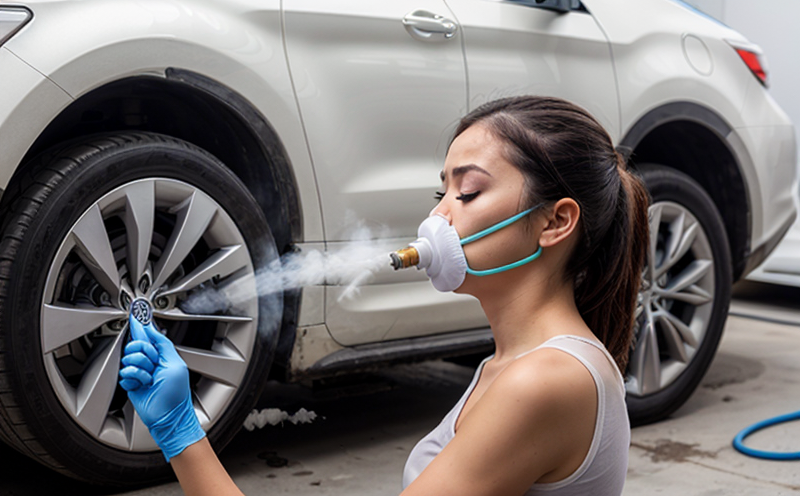EPA 8260 Volatile Organic Emission Testing
The EPA 8260 standard is a comprehensive protocol designed to evaluate volatile organic compound (VOC) emissions from various materials and products. This testing method ensures that the emitted VOCs do not exceed safe limits as specified by environmental regulations. VOCs, such as benzene, toluene, ethylbenzene, and xylenes, are common pollutants found in numerous consumer goods and industrial processes.
The EPA 8260 methodology is particularly important for ensuring compliance with the Clean Air Act (CAA), which aims to protect public health by regulating air pollutants. Compliance officers, quality managers, and R&D engineers rely on this testing protocol to ensure their products meet stringent environmental standards. The test involves a series of steps that include sample preparation, emission measurement, and comparison against established limits.
Sample preparation is critical in VOC emissions testing as it directly affects the accuracy of the results. This step typically includes selecting appropriate samples based on the product type, ensuring they are representative of the material being tested, and preparing them according to EPA 8260 guidelines. The apparatus used for this process may vary depending on the sample type but generally involves desorption techniques such as headspace or solvent extraction.
The emission measurement phase is conducted in a controlled environment where samples are exposed to conditions that simulate real-world scenarios. This allows for an accurate assessment of VOC emissions under various environmental stressors, ensuring reliability and validity of results. The testing equipment used can range from gas chromatography-mass spectrometry (GC-MS) systems to simpler air monitoring devices.
Results from EPA 8260 are compared against established emission limits defined by the Environmental Protection Agency or industry standards like ISO, ASTM, EN, and IEC. Compliance with these limits is crucial for maintaining environmental integrity and public health safety. Non-compliance can lead to significant legal and reputational risks.
Regular testing helps manufacturers identify potential issues early in the product lifecycle, allowing them to make necessary adjustments before products reach the market. This proactive approach not only enhances compliance but also contributes positively to sustainability efforts by reducing environmental impact.
| Industry | EPA 8260 Application |
|---|---|
| Plastics Manufacturing | Testing for emission of VOCs from plastic products. |
| Paint and Coatings Industry | Evaluation of solvent emissions during production processes. |
| Cleanroom Construction | Ensuring materials used in cleanrooms do not emit harmful VOCs. |
The importance of EPA 8260 extends beyond mere compliance; it plays a vital role in fostering a sustainable future by promoting the use of environmentally friendly materials and practices. By adhering to this standard, industries contribute significantly towards reducing air pollution and protecting ecosystems.
In conclusion, EPA 8260 Volatile Organic Emission Testing is essential for maintaining high standards of environmental protection across various sectors. Its rigorous protocols ensure that products emit VOCs within safe limits, thereby supporting both regulatory compliance and sustainable development goals.
Industry Applications
- Plastics manufacturing: Ensuring emissions from plastic products meet strict standards.
- Paint and coatings industry: Evaluating solvent emissions during production processes.
- Cleanroom construction: Guaranteeing materials used in cleanrooms do not emit harmful VOCs.
This testing method is widely utilized by industries that produce or utilize products known to release VOCs, ensuring their environmental impact remains minimal. By adhering to EPA 8260 guidelines, these companies contribute significantly towards protecting public health and preserving natural resources.
Environmental and Sustainability Contributions
EPA 8260 Volatile Organic Emission Testing plays a crucial role in enhancing environmental protection by ensuring that products do not emit VOCs above allowable levels. This testing method supports sustainability initiatives by promoting the use of environmentally friendly materials and practices.
By reducing air pollution, EPA 8260 helps to protect ecosystems and improve overall quality of life. Compliance with this standard not only mitigates health risks associated with exposure to harmful VOCs but also reduces greenhouse gas emissions, contributing positively to climate change mitigation efforts.
The rigorous protocols involved in EPA 8260 testing encourage manufacturers to innovate and develop more sustainable products. This shift towards greener practices aligns with broader global sustainability goals aimed at reducing humanity's ecological footprint.
Use Cases and Application Examples
- Plastics manufacturing: Ensuring emissions from plastic products meet strict standards.
- Paint and coatings industry: Evaluating solvent emissions during production processes.
- Cleanroom construction: Guaranteeing materials used in cleanrooms do not emit harmful VOCs.
EPA 8260 testing is widely utilized by industries that produce or utilize products known to release VOCs. This ensures their environmental impact remains minimal while supporting regulatory compliance and sustainable development initiatives.





